From a Viking trading city called Bjørgvin to the modern city we know today, Bergen's history is a fascinating one.
Modern Bergen is known as the gateway to the fjords and is an important economic centre in western Norway. With millions visiting each year, Norway’s second city is thriving.
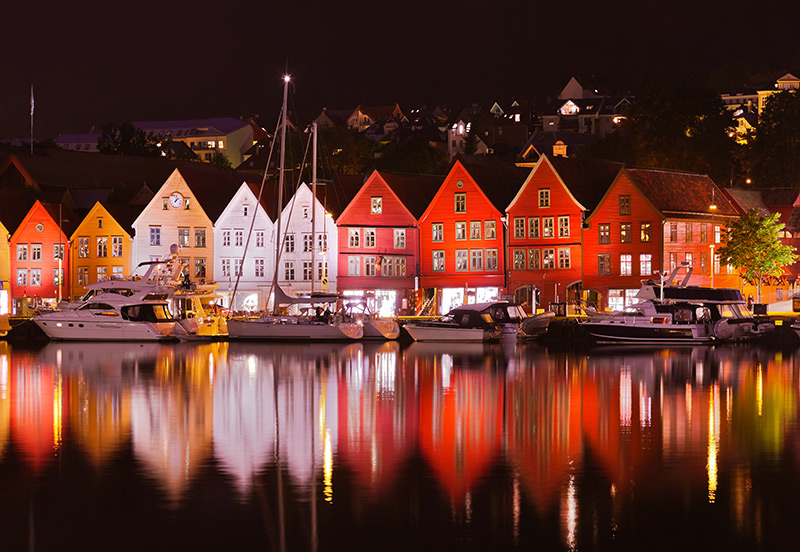
Aside from its proximity to the fjords, many of the city's attractions are historic in nature.
From the UNESCO World Heritage Site Bryggen to Fantoft Stave Church, Bergen is a must-visit destination for history buffs. If you're planning a trip or you just fancy an armchair tour, make a cup of coffee and find somewhere comfortable!
How did Bergen grow from a tiny little market town to a city of global significance? We start, as always, with the Vikings.
The founding of Bergen
Well technically we start with the end of the Vikings. In 1066, the English defeated King Harald Hardråde at the Battle of Stamford Bridge.
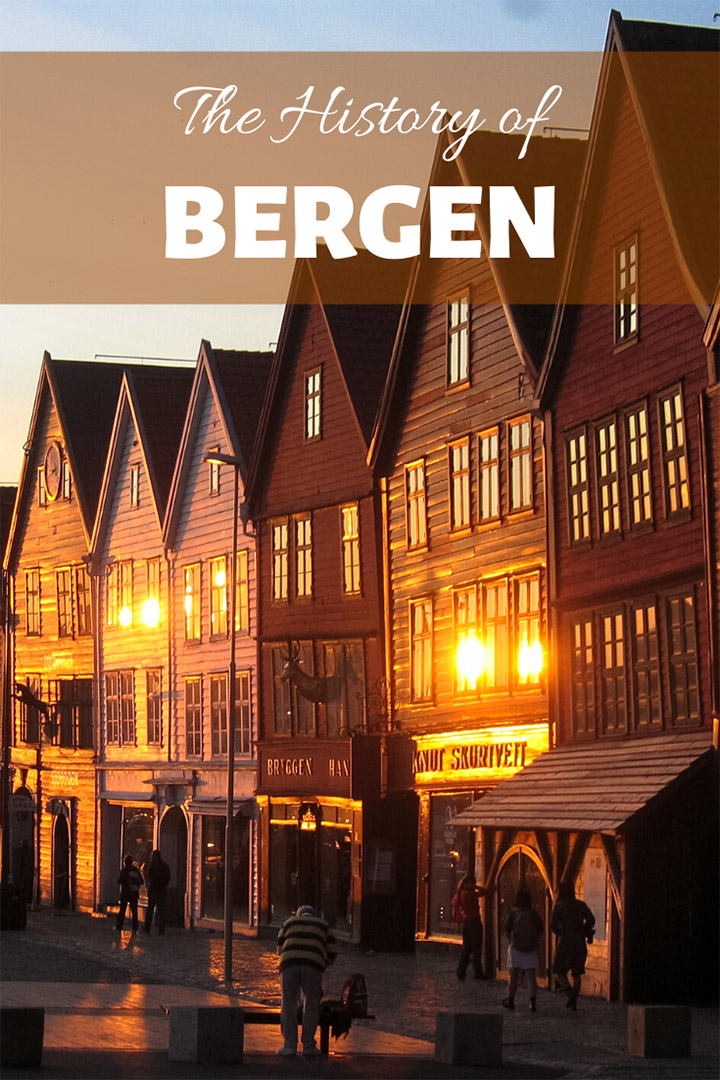
Many scholars agree that this is effectively the end of the Viking Age. His successor, Olaf Haraldsson, (Olaf III of Norway) returned to Norway after seeing his father perish.
Olaf was also known as Olaf Kyrre, from the Old Norse Kyrri meaning Peaceful and it’s a very apt moniker. The 26 years of his rule were among the most peaceful that Norway had ever seen. Olaf set about making peace with everyone – the Swedes, the English, the Church – and modernising his Kingdom.
Read more: The Viking Timeline
In 1070 (or thereabouts – records weren’t quite as accurate as they are nowadays!) Olaf founded the city that today we call Bergen. Its original name, Bjørgvin, means ‘the green meadow among the mountains’. There had possibly been trading in the area for around 50 years, but Olaf established the place as a city in its own right.
Bergen as the capital of Norway
Over the following 150 years, Bergen grew as a major trading city. Its location on the west coast made it ideal for accessing the rest of the world. During the early part of the 13th century, Bergen gradually took over the role of Norway's capital from Trondheim (then known as Nidaros).
The driving force for this was the death of King Inge II and a subsequent dispute over the throne. The eventual winner was Haakon IV who had massive popularity in the West of Norway against the pretenders from Nidaros. So it was sensible after assuming the throne to seat power in the area of his highest popularity.
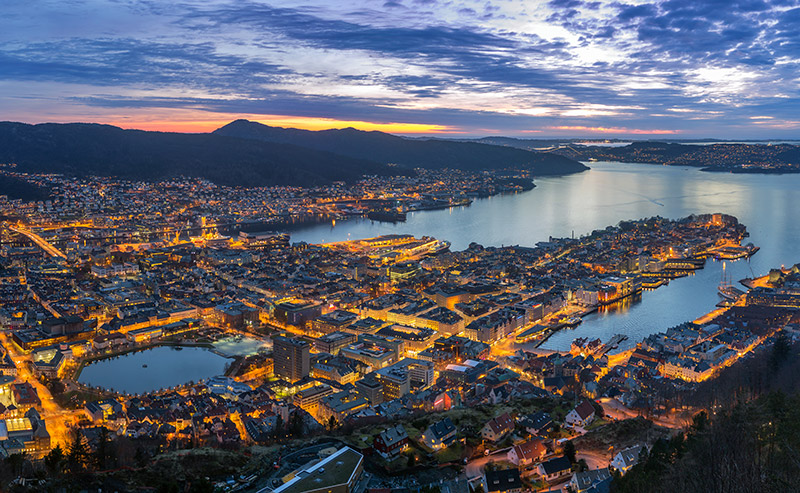
During its time as capital, the first attempts at a central administration started. The Bergenhus Fortress was begun in around 1240 and buildings from that time survive today. This complex of buildings contained the royal residence, fortifications and Christ Church. The church was originally initiated by Olaf III back in the 11th century.
Bergen’s role as capital was, however, fairly short-lived. When King Magnus ‘The Law-mender’, Haakon IV’s son, died, he was succeeded initially by his elder son Eirik who maintained the residence in Bergen. His younger brother Haakon was named Duke of Norway and ruled over large parts of southern Norway including Oslo.
Eirik died and Haakon ascended to the throne in 1299 as Haakon V. Then, it was inevitable that his residence, and therefore the capital, would be in Oslo.
Life after Oslo
Rather than dwindle when the seat of government moved south to Oslo, Bergen continued to thrive. Bergen was still the largest city in Norway and remained so until the 1830s when Oslo finally overtook it.
As a trading city, Bergen had established itself as the principal source of dried cod in Europe. The city was home to many North German merchants who would trade with the fishermen who came down from the north of Norway each summer.
The German merchants lived in their own area of the city and kept their own language. Bergen had exclusive rights to the sale of fish products from the North of Norway.
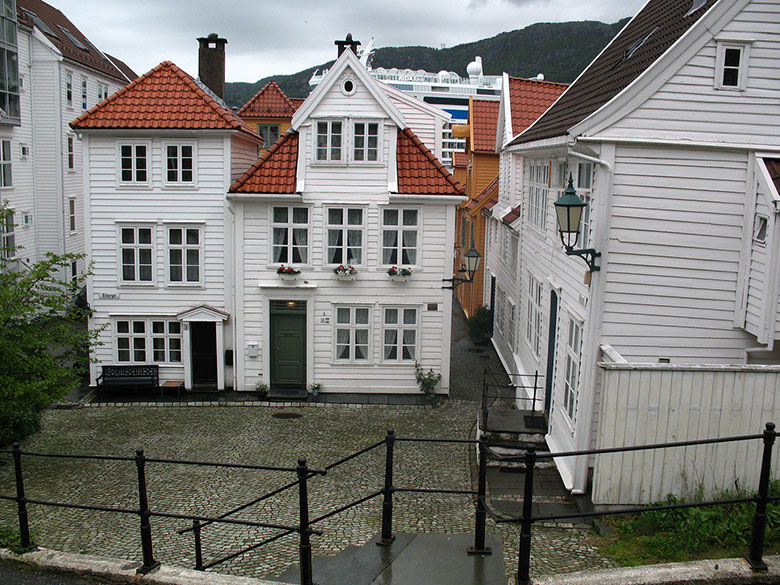
In the middle of the 14th Century, Bergen’s importance in global trade was recognised when it was made one of the four Kontore – foreign trading posts – of the Hanseatic League. The League was a confederation of merchant guilds and market towns that spread from Germany to, at its height, cover the whole of the Baltic and North Seas.
The Hanseatic dominance of Bergen started to dwindle in the 18th century, in favour of Norwegian merchants, and the Kontor was finally closed in the 1750s. Bergen maintained the monopoly on trade with Northern Norway until 1789.
The remnants of the Hanseatic League can be seen in Bergen today in the form of Bryggen. The quayside is lined by old commercial buildings that were used by the League. This is the only Kontor to survive to the present day and has been listed as a UNESCO World Cultural Heritage site since 1979.
Fires in Bergen through history
Throughout history, Bergen has been beset with numerous fires. The first came in 1198 when, during the civil war, the Bagler (aristocracy) faction set fire to the city. This was done as part of a battle against the Birkebeiner (rebels/poor) faction. Fifty years later, Holmen and Sverresborg burned with the loss of 11 churches.
Read more: Trondheim in Flames
Incredibly, Bergen and its surrounding areas saw no fewer than four major fires in the 15th century. In 1413, 14 churches were destroyed by flames. Then in 1428, the city was plundered and burned by the vicious Victual Brothers – privateers/pirates who terrorised the North and Baltic seas.
Hanseatic merchants burned down Munkeliv Abbey in 1455. A few years later in 1476, a fire burned through Bryggen after a drunken trader accidentally set fire to the area. 250 years then passed with only three fires – 1582 in Stransiden, 1675 in Øvregarten and Strandsiden again in 1686. The latter dire saw 231 city blocks and 218 boathouses ravaged by fire.
18th Century Bergen was, once again, hit with four fires, including the worst in its history. In 1702, about 90% of the city was destroyed. 1751 in Vågsbunnen and then two fires in unlucky Strandisden in 1756 and 1771.
Fortunately, 19th Century Bergen escaped unscathed. Just as it seemed the city had turned a corner in its infernal history, our old friend Strandsiden burned for the fifth time in 1901. In 1916, a relatively small fire burned 300 buildings in the city centre. Our journey through the history of Bergen in flames ends in 1955, when a fire once more burned down parts of Bryggen.
What’s in a name?
The name of the city was, as mentioned above, Bjørgvin or Bergvin in Old Norse. Bjorg or berg means mountains and vin means settlement where there was meadowland and so the city is the meadow in the mountains.
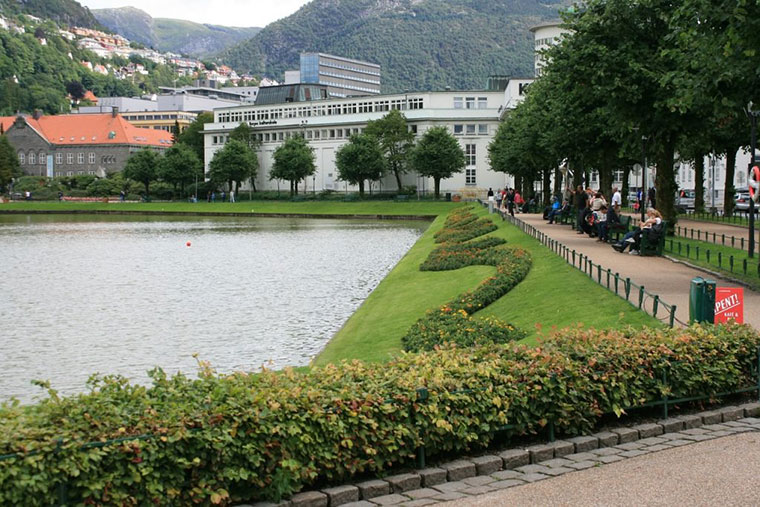
In the early 20th century there was a campaign to have the Old Norse name of Bjorgvin reinstated, but it was unsuccessful. Instead, the name of the diocese was changed to Bjøgvin bispedømme in its honour. The name lives on in Icelandic where the city is still referred to as Björgvin.
Inspired by the ‘seven hills of Rome’, the Bergen playwright Ludvig Holberg named Bergen ‘the city among seven mountains’. As there are actually nine mountains surrounding the city, there are often arguments as to which the seven mountains are!
Ulriken, Fløyen, Løvstakken and Damsgårdsfjellet are always included. That leaves three of Lyderhorn, Sandviksfjellet, Blåmanen, Rundemanen and Kolbeinsvarden. Gullfjellet is Bergen's highest mountain, at 987 metres (3,238 ft) above mean sea level.
The mountains surrounding Bergen are responsible for the micro-climate that produces the city’s copious rainfall. The moist air from the North Atlantic lifts up the mountains and forms clouds, which then prey on the public below. On average, the city receives on 195 days of the year.
A musical history of Bergen
Varg Vikernes from the Norwegian black metal band Mayhem might disagree but arguably the most famous musical son of Bergen is the pianist and composer Edvard Grieg. Grieg was born and died in Bergen but travelled extensively during his life.
Grieg is considered one of the foremost composers of the later romantic period and his work is still performed widely around the world. Much of his work developed themes from Norwegian folk music. As such, Grieg is credited with helping to develop a sense of national identity for Norwegians and for promoting the country throughout the globe.
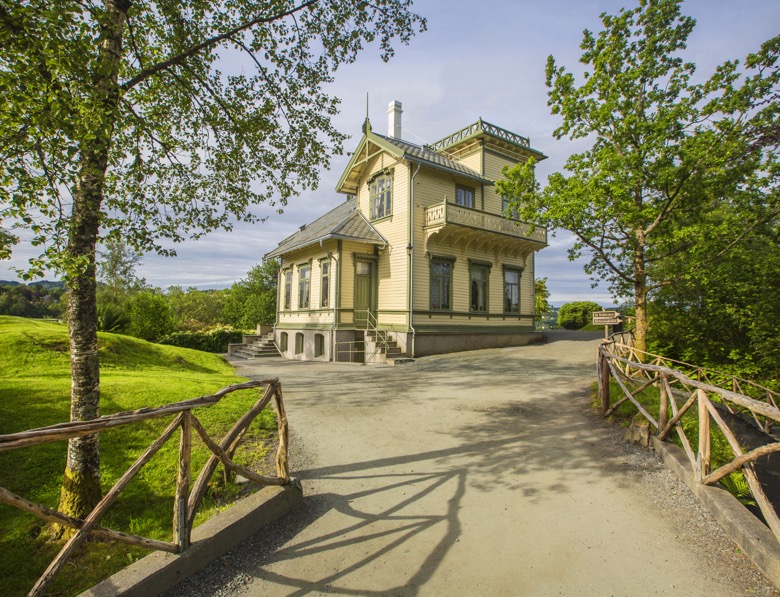
A concert pianist, Grieg studied at the Leipzig Conservatory before travelling around Europe. He met and worked with various other composers such as Liszt and Tchaikovsky. His most famous work to most people is the music he wrote to accompany Henrik Ibsen’s play Peer Gynt. In particular, In The Hall of the Mountain King will be instantly recognisable to most people.
Even though Grieg overshadows pretty much all other musicians from Bergen, the city has produced other notable musicians. The soprano Sissel Kyrkjebø hails from the city and is noted worldwide for having worked with Domingo and Carreras. She also contributed to the soundtrack for the movie Titanic.
As well as Varg Vikernes and various other Black Metal musicians, Bergen is also known for the Bergen Wave. The city produced or nurtured a number of bands that came to international recognition such as Kings of Convenience and Röyksopp.
Bergen in World War II
Norway's second biggest city was occupied throughout much of the second world war. German warships successfully approached Bergen from the water and took control of the city in April, 1940.
The city became an important strategic centre for occupying forces. But it also proved an important base for Norwegian resistance activities.
Historical Bergen today
The history of Bergen is visible today in many of its landmarks and sights. As the city’s most famous son, it’s no surprise that much is made of Grieg's name. The main concert hall (Grieg Hall), music school (Grieg Academy) and choir (Edvard Grieg Kor) all bear his name.
In addition, the city has dedicated many statues in his honour. Unsurprisingly, there is also a Grieg Museum in his old home of Troldhaugen where visitors can learn all about the life and works of Norway's premier composer.
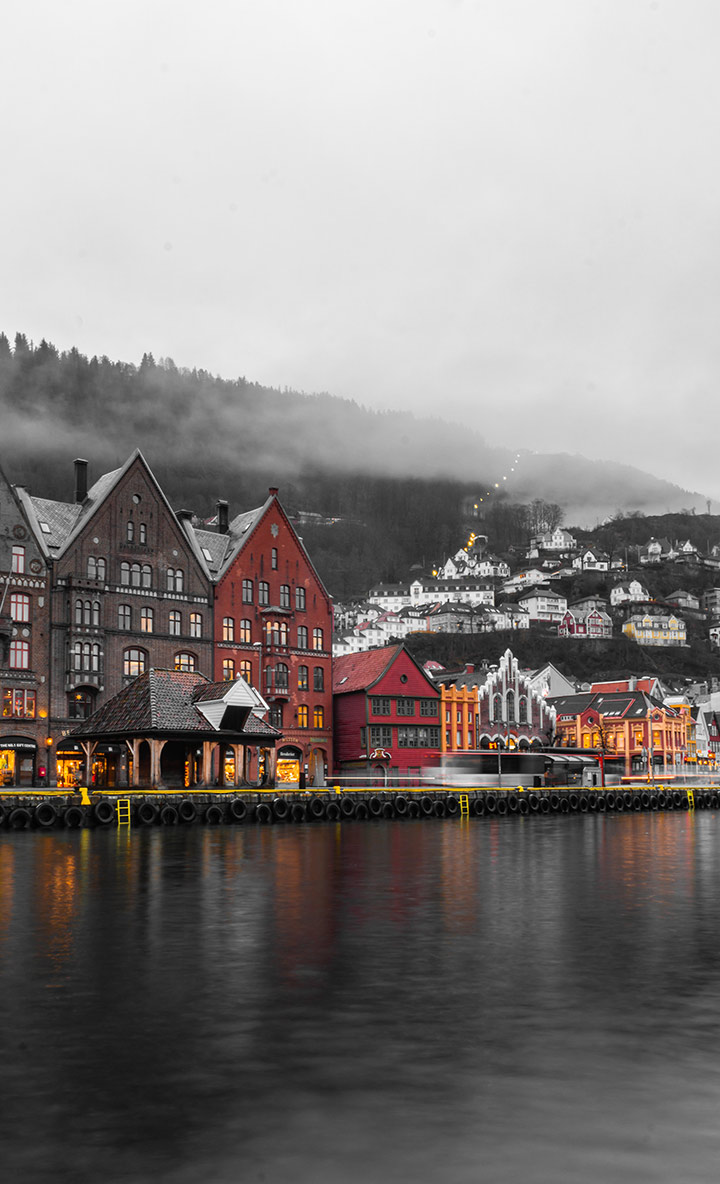
Bryggen is also a well-preserved symbol of the history of both the city of Bergen and the Hanseatic League. Despite burning several times, most recently in 1955, the quaint and beautiful row of merchant buildings has been fully restored each time. The site is a UNESCO World Heritage site and is worth a stop on anyone's itinerary.
Read more: Bergen Travel Guide
Bergenhus Fortress stands at the entrance to Bergen harbour. It is one of the oldest and best preserved stone fortresses in Norway. Some of the existing buildings date back as far as the 13th century while the most recent parts date to World War II. Parts that were damaged during the war were later restored.
The fortress has been used extensively throughout Norway’s history. In the 19th century, the fortress lost its status as a defensive structure and was then mostly used as an administrative centre for the armed forces.
The fortress today is still owned by the Norwegian Navy which as around 150 personnel stationed there. In addition, Haakon’s Hall and Rosenkrantz Tower are open to the public. Koengen, the central part of the fortress, is used as an open-air concert venue.
Have you visited any of the historical sites of Bergen? Let us know what you thought in the comments.


Visited Bergen for 2 days in April this year and simply fell in love with the city…its undoubtedly one of the most beautiful cities which is a heady mix of old world charms and a thriving metropolis at the same time…can’t wait to be there again soon to explore its charms, at a different time of the year next time maybe. 🙂
I LOVE BERGEN
Have been lucky enough to visit Bergen 4 times. Marvelous site. Always have to go to the market and have an open face sandwich ! !
Also, is there a print version of ALL of the Viking history sections you have highlighted? I am trying to put one together from all you have posted, but it is getting Exhausting doing screen shots, then cutting and blending. What you post os so much better than any other source I have found. Please respond to my email. Turns out I am also related to many of the kings you have mentioned, AND many of the opposition at Stamford Bridge ! ! Who Knew !
I been to Bergen 8 times. I love Bergen. I always schedule extra time before and after the Hurtigruten cruises I have gone on. It is beautiful, and there is so much to see. The last time I was there was in December. It snowed while I was there, and the city was like a Christmas post card. It was so beautiful. I would live there if I could.